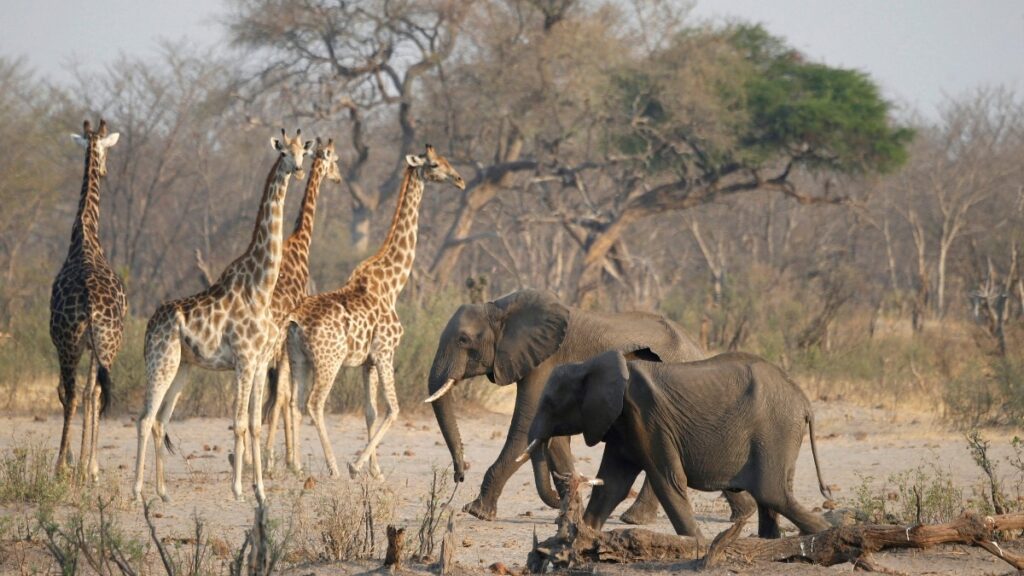Namibia, spread over 8.25 lakh square kilometers, is battling drought and famine. The situation is such that now efforts are being made to satiate the hunger of the people by killing wild animals. The government has ordered the killing of more than 700 wild animals, whose meat will be distributed among the poor so that their hunger can be satiated.
The Namibian government has ordered the killing of wild animals last week. The government has asked to hunt a total of 723 wild animals and distribute their meat among the poor.
The animals which the government has ordered to be killed include 30 hippos, 60 buffaloes, 100 blue wildebeests, 300 zebras, 83 elephants and 100 elands. Till last week, 157 of these animals have already been killed. 57,875 kg of their meat has already been distributed in drought affected areas.
The situation in Namibia has been bad for almost a year. There was a drought due to lack of rain and increased heat. This led to famine. This is why the government has now ordered to kill wild animals and distribute their meat to satiate the hunger of the people.
How bad is the situation in Namibia?
Due to drought, Namibia’s President Nangolo Bumba declared an emergency on 22 May this year. Drought is not a new thing in African countries like Namibia. But this time Namibia is facing the worst drought in 100 years.
According to the United Nations, till last month, 84% of the food reserves Namibia had were exhausted. This means that now even the government does not have enough food left to distribute among the people to satiate their hunger.
Not only this, the United Nations has warned that the situation of starvation in Namibia will worsen further in the coming months. It is feared that in the coming few months, more than half of Namibia’s population will face a terrible food crisis.
But how did this happen?
Not only Namibia, but other countries of South Africa are also facing drought. It started from October last year. This happened because the heat increased and the rainfall decreased.
According to information, Namibia receives the most rainfall in February. But this year, not even 20% of the rain that was expected in this month fell. 92% of Namibia is either extremely dry or completely dry. Due to less rainfall, the situation has gone from bad to worse.
Due to lack of rain, the production of grains also decreased. According to the United Nations, due to this, the production of grains decreased by 53%. Whereas, the water level in the dam also decreased by more than 70%.
The reason for the lack of rain is believed to be the El Niño effect. Due to El Niño, the temperature becomes hot and there is no rain. Emergency has been declared in countries like Namibia, Zimbabwe, Malawi and Zambia.
These 3 things increased the trouble!
– Climate: Namibia is the driest country in Africa. On an average, less than 10 inches of rain falls here every year. However, some areas receive up to 25 inches of rain. But this year, there has been nominal rainfall here. After a little rain in February-March, not a single drop of water has rained here since April. Due to lack of rain, grain is not being produced. Due to this, conditions of famine have arisen.
– Inflation: The inflation rate has been above five percent on an average every month between May 2023 and May 2024. Inflation is constantly rising due to rising prices of food items and tobacco, electricity, gas and petrol. Due to the increase in petrol prices, the prices of food and non-food items have increased, which has affected the income of the people.
– Unemployment: Namibia is one of those countries where unemployment is the highest. Right now the unemployment rate here is around 20 percent. Whereas, 46 percent of the youth are unemployed here. Due to unemployment, poverty is also quite high here. According to the United Nations, one out of every three children in Namibia is born in a poor family. Not only this, 44 percent of the population here lives in poverty.
Will killing animals solve hunger?
Generally, drought and famine are not a big deal in Namibia. But this time the situation has become much worse.
However, the order to kill animals is also being linked to politics. Actually, there are presidential elections in Namibia in November this year. All 14 regions of Namibia have been badly affected by drought. Experts believe that the purpose of ordering to kill animals is not to satisfy the hunger of the people but to divide their votes. The ruling party is facing challenges in rural areas like Kavango and Caprivi, so this step has been taken to divide the votes of the people here.
There are many countries around the world where wild animals are killed and their meat is eaten. In Namibia, it is common to eat the meat of animals like zebra, blue wildebeest and impala.
A statement issued by the Namibian government states that due to drought, animals may migrate in search of food and water, which may increase their conflict with humans. There are more than 24 thousand elephants in Namibia alone. The government hopes that if the animals are hunted, other animals will get food and water. Along with this, hunger can also be overcome with animal meat.
However, experts believe that instead of ordering the hunting of wild animals like elephants, the government should decide to kill cattle and domestic animals. The government should buy cattle from farmers and distribute their meat. Not only this, there is also a risk of spreading many diseases. Experts say that eating the meat of wild animals can spread many diseases among humans.
Source (PTI) (NDTV) (HINDUSTANTIMES)
